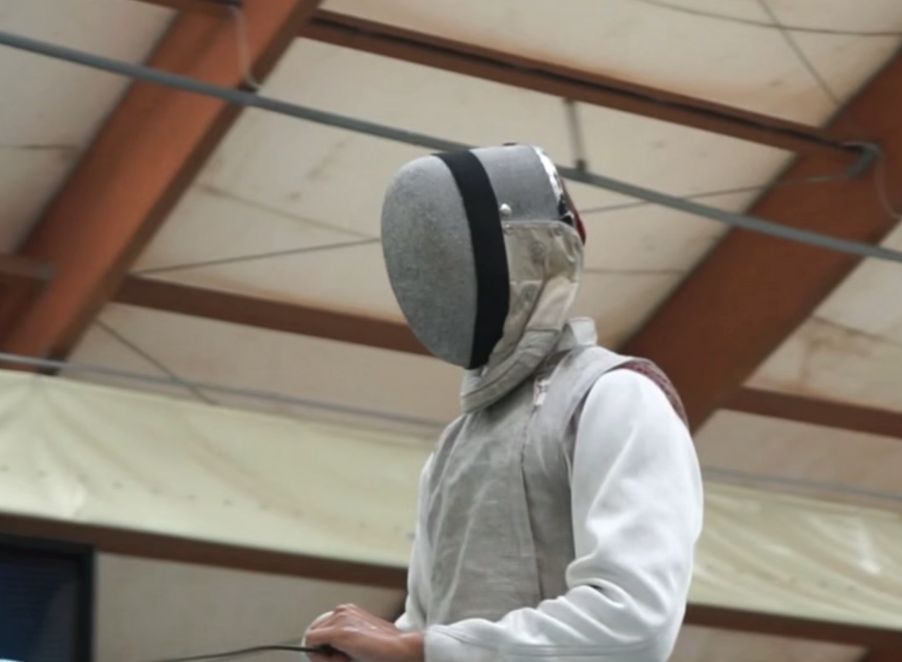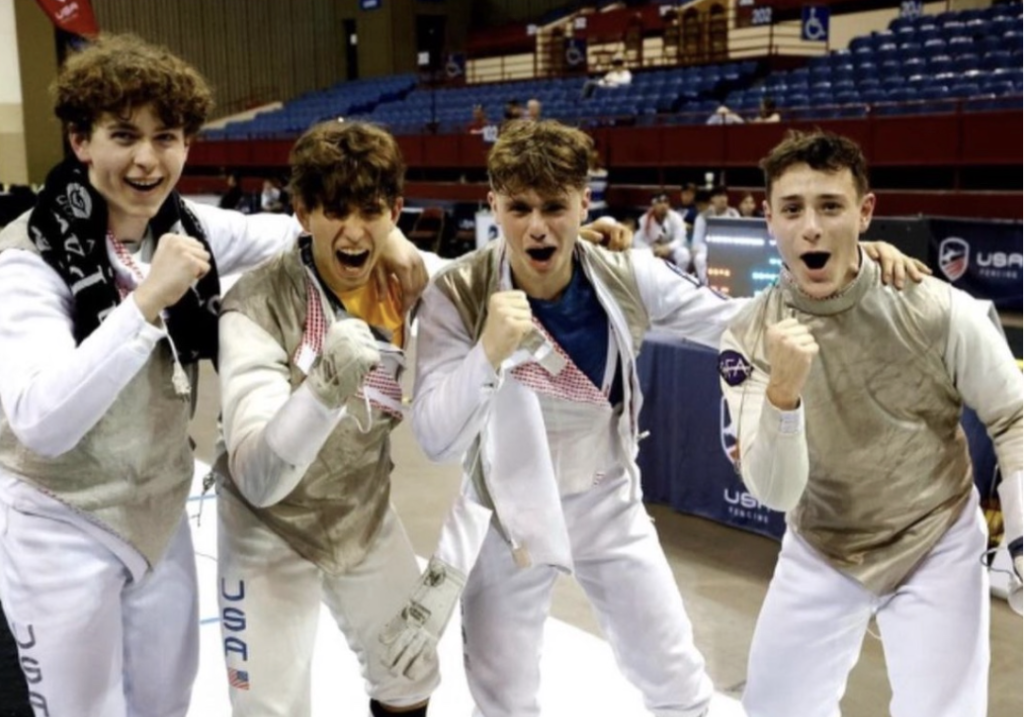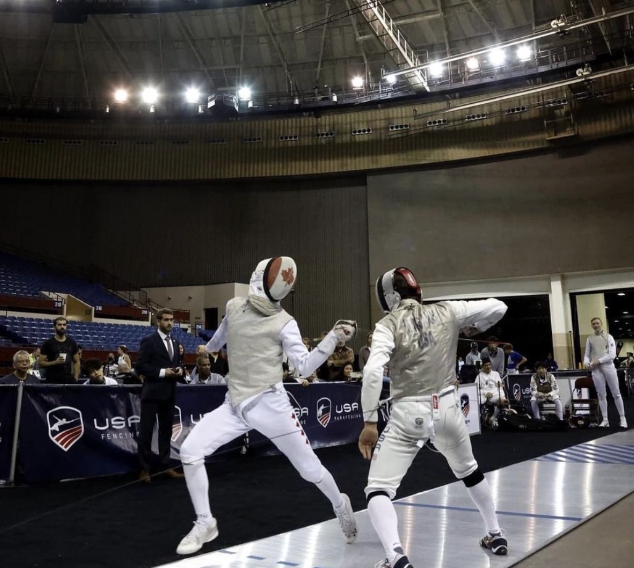From legionnaires in Rome to samurai in Japan to knights in medieval Europe, mastery of the sword has long been associated with power, honor and skill. But as firearms and other ranged weapons became more dominant on the battlefield, the necessity of swords and other melee weapons declined. In recent centuries, the practice of swordsmanship evolved from a martial skill into an organized sport, one of which we recognize today as fencing.
Philip Matsakh is a Form V student and an All-American fencer at the Fieldston Upper School. He began his fencing career, strangely enough, as a ballroom dancer. “I had really poor hand-eye coordination then,” he remembers with a self-deprecating smile, “which prompted my mother to enroll me in ballroom dance. After about a year, I decided to find something new.” As luck would have it, there was a fencing club on the same block.
Young Philip Matsakh with Olympian Miles Chamley-Watson
Source: Philip Matsakh
The rest was history.
Fencing would take Matsakh from local classes to compete on the national and international stage. Matsakh proudly recalls, “Leading my team to victory at the Junior Team event at the North American Cup in November 2023 was the highlight of my fencing career because it brought my friends from all across the country together, and we accomplished something great.” The fencing community, he says, is “really welcoming and very diverse. Members come from all around the world with different backgrounds. Funny enough, a fencer’s style often reflects their personality off the piste (the playing strip fencers spar on).”
Fencing developed as a sophisticated art form in Europe during the Renaissance, especially in France, Italy and Spain. It was first intended for duels and self-defense, but early fencing masters in these countries established schools that taught strict rules of sportsmanship and discipline in addition to simple technique. These schools helped shape fencing into a methodical sport, distinguished by its emphasis on skill over brute force. The popularity of fencing grew rapidly, especially among young noblemen. Horsemanship and fencing were among two of the most popular hobbies in aristocratic society.
In the 19th century, as aristocratic practices became democratized, and popular sports were invented, national and international fencing associations began to form. This codified rules and sets of guidelines that remain largely in place today. In the last century, fencing expanded beyond the aristocracy and became much more accessible to the public. Fencing made its debut in the first modern Olympic Games in 1896 and has been a fixture of the Olympic program ever since, solidifying its place as a world-renowned sport.
Matsakh trains at Tim Morehouse Fencing Club. A typical training session kicks off with a 40-minute warm-up, consisting of 15-20 minutes of running, followed by a 3-minute water break. Once hydrated, the athletes return for another 15-20 minutes of stretching. Following the warmup are rigorous footwork drills. These drills include sequences of advances, retreats and lunges. The majority of each training session is dedicated to sparring, where fencers compete first in 5 touch bouts to determine their seed for the 15-touch tableau. Finally, the group winds down with a cooldown session. Partner stretching, pull-ups and calf raises help athletes recover from the 3-6 hour sessions and prepare them for the next practice.
Philip Matsakh in Men’s Foil Final At Future Champions Camp Tournament
Source: Future Champions Camp (Tirrenia, Italy)
Matsakh says animatedly, “I love fencing because of how difficult and different it is. Fencing requires many different skills, including physical strength, endurance, confidence, and resilience…The adrenaline rush you get during a tournament is definitely my favorite feeling.”
Matsakh has his sights set on collegiate fencing, and with the wide array of fencing programs across the country that offer amazing opportunities both academically and athletically, the future looks promising. Nonetheless, Matsakh’s journey has not been without its challenges.
Balancing academics, sports and socialization is a challenge for many, including Matsakh. “The hardest part about being a student-athlete is having enough time to fence, perform in class, do homework and still have a social life. But the most difficult part of all is the lack of sleep,” he admits.
But, as with most sports, the rewards of such a demanding schedule are great. Sports are formative. “Fencing has shaped me into being a much more organized and decisive person.” The skills he’s developed – teamwork, emotional control under stress, communication and respect – translate directly into his life as a student. He notes how team events in fencing are not unlike group projects in the classroom since “both utilize teamwork and communication skills.” Collaboration will be a highly useful skill in Matsakh’s life.
Philip and his teammates after winning Junior Men’s Foil Team event at the North American Cup, November ‘23
Source: USA Fencing by Serge Timacheff
Another lesson Matsakh has gained from his career as a fencer is the ability to learn from his mistakes and overcome injuries, the Achilles heel of all athletes. Matsakh recalls his biggest setback being “a stretch of injuries in 8th-9th grade. I sprained my ankle 5 times, almost back to back, and was dealing with Osgood-Schlatter, which causes inflammation in the Patellar tendon (right below the knee). I overcame these hurdles as time went on since that was the only thing that would heal my knee issues. But more importantly, it taught me how to find ways to improve even with obstacles in the way.” Matsakh says these lessons are the best part of fencing. “Don’t give up, even when it seems like you have no chance,” Matsakh encourages.
USA vs. Canada
Source: USA Fencing by Serge Timacheff
Though fencing has evolved from the battlefields of old, for young fencers like Philip Matsakh, the sport remains as relevant as ever: a timeless test of skill and discipline that changes lives both on and off the piste.
The sword, once a weapon of war, now serves a new purpose.










